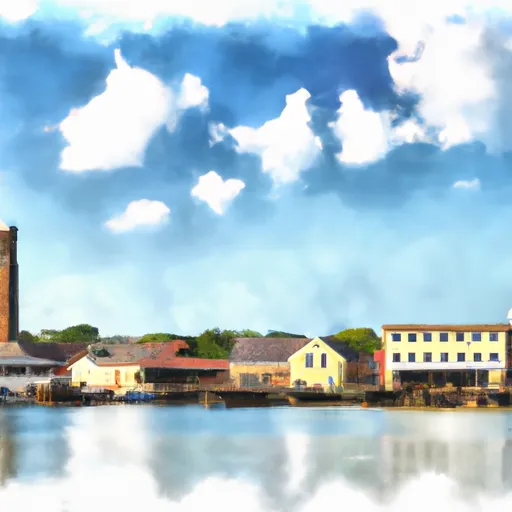-
 Snoflo Premium
Snoflo Premium
Get unlimited access to all our content
With no Ad interruptions! - Start Your Free Trial Login with existing account
Port-Tobacco
Eden Index
Climate
8.3
•
Recreation
6.9
•
Community
•
Safeguard
5.7/10

Port Tobacco, Maryland is a picturesque town located in Charles County, on the banks of the Port Tobacco River. The climate in Port Tobacco is characterized by warm summers and mild winters. Summers are generally hot and humid, with average temperatures ranging from the high 70s to the low 90s Fahrenheit, while winters are relatively mild, with temperatures averaging in the 30s and 40s.
The hydrology constituents in Port Tobacco are primarily centered around the Port Tobacco River. The river serves as a tributary to the Potomac River, offering stunning views and recreational activities such as boating, fishing, and kayaking. The Port Tobacco River Park is a popular spot for outdoor enthusiasts, providing hiking trails, picnic areas, and wildlife watching opportunities.
In addition to its natural beauty, Port Tobacco is steeped in history, with numerous historic sites and landmarks, including the Port Tobacco Courthouse and St. Ignatius Church. Visitors can experience the charm of this small town while exploring its rich heritage.
Overall, Port Tobacco, Maryland offers a pleasant climate, scenic waterways, and a variety of outdoor activities, making it an ideal destination for nature lovers and history enthusiasts alike.
What is the Eden Index?
The Snoflo Eden Index serves as a comprehensive rating system for regions, evaluating their desirability through a holistic assessment of climate health, outdoor recreation opportunities, and natural disaster risk, acknowledging the profound impact of these factors on livability and well-being.
Climate Health Indicator (CHI): 8.3
Port-Tobacco receives approximately
1126mm of rain per year,
with humidity levels near 80%
and air temperatures averaging around
14°C.
Port-Tobacco has a plant hardyness factor of
7, meaning
plants and agriculture in this region tend to thrive during the non-winter months.
By considering the ideal temperature range, reliable water supplies, clean air, and stable seasonal rain or snowpacks, the Climate Health Indicator (CHI) underscores the significance of a healthy climate as the foundation for quality living.
A healthy climate is paramount for ensuring a high quality of life and livability in a region, fostering both physical well-being and environmental harmony. This can be characterized by ideal temperatures, reliable access to water supplies, clean air, and consistent seasonal rain or snowpacks.
Weather Forecast
Streamflow Conditions
Potomac
Area Rivers
Potomac
Snowpack Depths
Potomac
Reservoir Storage Capacity
Potomac
Groundwater Levels
Recreational Opportunity Index (ROI): 6.9
The Recreational Opportunity Index (ROI) recognizes the value of outdoor recreational options, such as parks, hiking trails, camping sites, and fishing spots, while acknowledging that climate plays a pivotal role in ensuring the comfort and consistency of these experiences.
Access to outdoor recreational opportunities, encompassing activities such as parks, hiking, camping, and fishing, is crucial for overall well-being, and the climate plays a pivotal role in enabling and enhancing these experiences, ensuring that individuals can engage in nature-based activities comfortably and consistently.
Camping Areas
| Campground | Campsites | Reservations | Toilets | Showers | Elevation |
|---|---|---|---|---|---|
| Pohick Bay Regional Park | 150 | 126 ft | |||
| Andrews AFB Military | None | 269 ft | |||
| Fort Belvoir Travel and RV Camp | 52 | 132 ft | |||
| Louise F. Cosca Regional Park | 23 | 223 ft | |||
| Cedarville State Forest | 27 | 198 ft | |||
| Greenbelt Park | 175 | 121 ft | |||
| Smallwood State Park | 15 | 16 ft |
Nearby Ski Areas
Catastrophe Safeguard Index (CSI):
The Catastrophe Safeguard Index (CSI) recognizes that natural disaster risk, encompassing floods, fires, hurricanes, and tornadoes, can drastically affect safety and the overall appeal of an area.
The level of natural disaster risk in a region significantly affects safety and the overall livability, with climate change amplifying these risks by potentially increasing the frequency and intensity of events like floods, fires, hurricanes, and tornadoes, thereby posing substantial challenges to community resilience and well-being.
Community Resilience Indicator (CRI):
The Community Resilience Indicator (CRI) recognizes that education, healthcare, and socioeconomics are crucial to the well-being of a region. The CRI acknowledges the profound impact of these elements on residents' overall quality of life. By evaluating educational resources, healthcare accessibility, and economic inclusivity, the index captures the essential aspects that contribute to a thriving community, fostering resident satisfaction, equity, and social cohesion.

